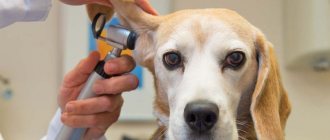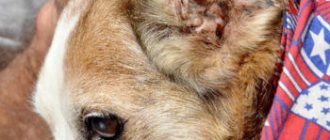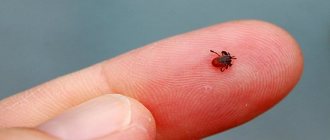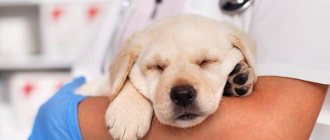Short description
The Labrador is a medium-sized, proportionally built dog, growing up to 50-57 cm at the withers and weighing between 25-36 kg. The broad, wedge-shaped head with prominent brows, flat cheekbones and a slightly convex forehead has dark almond-shaped eyes surrounded by well-pigmented eyelids and triangular drooping ears. Under the strong rectangular body with a wide neck and a flat topline are straight, strong limbs with strong joints and paws gathered into a ball. The entire body of such a dog is covered with dense, water-repellent fur of black, chocolate or fawn color.
The Labrador, whose photo cannot convey all its beauty, is endowed with a good-natured, flexible and completely non-aggressive disposition. He is quite trainable and gets along easily with other pets. This affectionate and sociable dog will happily play with the owner’s children and will never refuse long, active walks. With proper training, he makes an excellent companion, an excellent hunter and a worthy athlete, capable of winning competitions in freestyle, flyball or agility. What they lack in speed, they more than make up for in endurance and agility.
Maintenance and care
These animals adapt equally easily to life in a city apartment or in an indoor enclosure equipped with an insulated booth. But in both cases, it is important for him to be provided with the opportunity to regularly go on active long walks. A dog deprived of adequate exercise can develop serious illnesses. A Labrador that is unable to swim or run long distances will naturally slow down its metabolism, leading to excess weight gain.
In general, representatives of this breed are quite unpretentious and do not require special care. Their water-repellent coat does not require frequent washing and should only be brushed a couple of times a week. Because these animals have poorly ventilated, floppy ears, they need to be regularly examined for infections. The same amount of attention should be paid to the dog’s eyes and claws. It is advisable to wipe the former regularly, removing secretions accumulating in the corners, and the latter - to periodically cut them.
A separate item should be caring for the dog’s teeth, because the health of the dog’s digestive system depends on their condition. It is recommended to clean them using a special paste, sold at any pet store. The dog must be accustomed to this procedure from puppyhood.
How to keep your dog healthy for a long time
If you decide to get a Labrador, it is important to know how to keep your dog healthy. Measures must be comprehensive:
- Buy a puppy from trusted breeders. When selling second hand and “cheaper”, puppies are not checked for genetic pathologies. In addition, so-called breeders rarely pay attention to genealogy and the correct selection of breeding pairs. Be sure to make sure that the puppy has all the documents (not just a veterinary passport) and that he has passed a veterinary examination.
- Proper nutrition. Feed your dog balanced natural food or high-quality commercial food. If your pet is prone to excess weight or hormonal problems, it is better to immediately switch to grain-free commercial food.
- Physical exercise. Walk your puppy actively at least 2 times a day. Be sure to take long walks on weekends and in your free time.
- Prevention of parasites. Treat your dog regularly for fleas, ticks and worms. Veterinarians recommend treating your dog all year round, once every 1–3 months, depending on the chosen prophylactic agent.
Be sure to visit a veterinarian with your pet at least once every six months. Timely detection of illnesses in most cases facilitates treatment and gives a chance to improve the pet’s quality of life.
Nutritional Features
This is one of the most important factors affecting a dog's health. Improper and poorly balanced nutrition often leads to the development of serious diseases. Labradors that do not receive all the necessary minerals from their food begin to gradually lose their health. First, the condition of their fur, teeth and claws deteriorates, then their immunity decreases and their ability to resist infections is lost. To prevent this from happening, you need to provide the dog with proper nutrition.
The animal's diet can consist of industrial or natural food. In the first case, preference should be given to super-premium or holistic-class products produced by trusted global manufacturers. It is important to ensure that it does not contain wheat, corn, legumes or preservatives. In addition, the serving size should follow the manufacturer's recommendations. Systematic overfeeding is fraught with rapid weight gain and then you will have to put your Labrador on an obesity diet.
Those who decide to give their dog natural products need to understand that the basis of such a diet should be raw meat. It could be beef, lean lamb, turkey or chicken. Several times a week, it is advisable to replace the meat component with sea fish and offal. It is also recommended to diversify the dog menu with rice, buckwheat, eggs, vegetables, fruits, cottage cheese, curdled milk and kefir.
Having dealt with the main permitted products, you need to find out what you cannot feed your Labrador. Like any other dogs, representatives of this breed are prohibited from being treated to chocolate, sweets, baked goods, tubular bones and river fish. Smoked, salted, pickled and fried foods should be permanently excluded from the menu of these dogs. Animals should not be fed legumes, grains, citrus fruits or pork.
Health and life expectancy
In general, representatives of this breed are quite strong and hardy dogs. In good conditions and with quality feeding, they can live up to 13 years. But sometimes a balanced diet and excellent care are overshadowed by bad genetics, and then the dog’s body fails.
The list of the most common diseases that Labradors are susceptible to includes food allergies, interdigital dermatitis, lipoma, eczema, epilepsy, bloating and cataracts. Also, representatives of this breed are often diagnosed with atopy, angiosarcoma, diabetes mellitus and myasthenia gravis. In recent years, these animals have shown a tendency to retinal detachment, osteochondrosis, entropy, and dysplasia of the elbow and hip joints. Many of these ailments are inherited and to avoid them you just need to carefully study the pedigree of the puppy you like. And if there are dogs in it that have had similar problems, it is better to refuse the purchase.
Common diseases of adult Labradors
The main diseases of adult Labradors:
- Acquired dysplasia of the hip and elbow joint.
- Cataract.
- Retinal dysplasia.
- Progressive retinal atrophy.
- Hypothyroidism.
- Diabetes.
- Laryngeal paralysis.
- Oncology.
Important! Labradors are prone to obesity and food allergies. Unfortunately, when you gain excess weight, the risk of occurrence or exacerbation of all hereditary problems increases sharply.
Diseases of Labrador puppies and their signs
Lack of calcium and vitamin D leads to the development of rickets. In recent years, veterinarians are diagnosing this disease less and less, but inexperienced dog breeders should learn about its symptoms, since untimely treatment of this disease is fraught with irreversible consequences. Rickets is easily recognized by dramatically changed taste preferences, fearfulness, itching, impaired reflexes and fatigue. At the next stage, the puppy develops lameness and pain when pressing on the bones. Treatment of this pathology includes proper nutrition and taking vitamin complexes containing calcium.
It is not uncommon for puppies to develop a hernia. This disease in Labradors and representatives of many other breeds develops as a result of non-closure of the umbilical ring. A hernia can cause severe inflammation and pain, and you can get rid of it not only through surgery and with the help of a special massage.
Another common disease that affects puppies is distemper. It affects the lungs, nervous and digestive systems. It is easily recognized by high fever, refusal to feed, lack of reflexes and chills. The infected animal becomes lethargic and depressed. The puppy tends to hide in a secluded corner, vomits, the pads harden and crusts form on the nose.
Small Labradors can also get enteritis. This disease is accompanied by dehydration, lethargy, diarrhea, vomiting, lack of appetite and rapid weight loss. Without proper treatment, the dog may die.
Panosteitis is often diagnosed in young, rapidly growing animals. Dogs suffering from this disease experience a decrease in appetite, pain and lameness. Treatment of this pathology comes down to limiting physical activity and taking special medications. With age, puppies outgrow this disease and become full-fledged healthy dogs.
Labrador health
How to keep your Labrador healthy?
This chapter could have been titled differently: “With a Little Regular Prevention, You Won't Need Long-Term Treatment.” Prevention should begin when you choose your future puppy. By adopting a healthy puppy and following certain preventive measures, you can raise him to be a healthy dog. Choosing a Veterinarian It is important to establish a good working relationship with your veterinarian so that he or she will be able to answer questions you may have as your dog gets older. In addition, your veterinarian will help you create schedules for necessary preventive procedures. Often, breeders advise buyers of their puppies to have their own veterinarian who has been working with Labradors for a long time. Or you can ask for recommendations from neighbors and friends whose opinions are important to you. Let's say the breeder gave you a ready-made schedule of vaccinations or a certain diet for the puppy. But the vet advises something else. In this case, ask both the breeder and the veterinarian to explain why they chose this particular regimen, and then decide for yourself whose advice seems most convincing to you. If the veterinarian does not want to explain anything to you, but simply insists on his own, consult with a specialist who is more willing to explain. As soon as you bring your puppy home, schedule a thorough medical examination with your veterinarian. Even if the puppy has already been examined by the breeder's veterinarian, be sure to consult with your own veterinarian within 2-3 days of purchase to ensure that the puppy is truly healthy. By the way, the legislation of some states provides for the buyer's right to return the puppy to the breeder and get the money back if the puppy is unwell. These regulations usually require the buyer to immediately consult with a veterinarian so that their rights can be protected. So make an appointment with your veterinarian right away! Bring a sample of your puppy's stool with you to your consultation (we'll talk about this later). Vaccinations When you first visit the veterinarian, your puppy may receive a vaccination or simply be examined. This will depend on what vaccinations were previously given. In many states, the law requires the breeder to provide the buyer with a health report of the puppy, recording the procedures that have already been performed. In this case, you and your veterinarian can discuss which vaccinations your puppy needs and when, taking into account the characteristics of the area in which you live, since each area has its own typical diseases. Today, veterinarians often argue about the benefits and harms of vaccinations. Some researchers suggest that the use of a large number of vaccinations may provoke immune system diseases in dogs and cats, the number of which is now on the rise. They suggest reducing the number of vaccinations we give our pets and/or reducing the number of vaccinations given at the same time. Unfortunately, no one can say for sure how long a vaccination protects a dog from a specific disease. These questions are currently being studied, and in a few years we may have more information at our disposal. In the meantime, it's best to tell your veterinarian that you want the minimum vaccinations that can protect your puppy from serious diseases that are common in the area where you live. First of all, your Labrador needs to be vaccinated against canine distemper, adenovirus, parainfluenza, and parvovirus (DA2PPv or DHPPv). If you are using one of the so-called "super parvo" vaccines for parvovirus vaccination, you will need to give this vaccine every 3-4 weeks until the puppy is at least 12 weeks old. However, many veterinarians, including myself, believe it is wrong to stop vaccinations at such an early age. I recommend continuing vaccination until 15-18 weeks. I'll explain my point of view a little later. Caution for Internet Users
The Internet is filled with all kinds of discussions about vaccinations. Take a look at special sites. Just remember that most of the information on the Internet is people's personal opinions and may not be based on serious scientific testing or evidence. Always check how serious the source of information is. There are other vaccinations, but given the current discussions, I consider them optional (it's up to you to decide whether to take them or not). The leptospirosis vaccine is often combined with DA2PPv. But there are another 200 types, or serologic variants, of leptospirosis, and the serologic variants used in vaccines are not always the same as those that most commonly cause the disease in dogs. In addition, the vaccine provides immunity for a short time - approximately 3-6 months. A coronavirus vaccine is usually added to the core vaccine. This vaccine is not always used because coronavirus is not fatal like parvovirus and does not usually cause serious consequences in adult dogs. It’s better that the dogs get infected with the coronavirus and walk around with an upset stomach and diarrhea for several days, but I don’t want to give them another vaccine. Another disease for which there is a vaccine is tracheobronchitis, or as it is often called, kennel cough. But you will only need this vaccination if your Labrador goes to places where there are a lot of other dogs, for example, at dog shows or in dog hotels. Kennel cough is caused by a combination of many viruses and bacteria, but the vaccine only protects a dog from one type of bacteria - Bordatella bronchiseptica. This is why vaccination cannot completely eliminate infection with kennel cough, although it may alleviate the course of the disease. The kennel cough vaccine is given either by injection or by nasal drops. Another additional vaccine prevents the development of Lyme disease. There are currently two types of this vaccine on the market, each of which has its advocates and opponents. The first vaccine is called bacterin. The name itself means that the vaccine contains bacteria that cause Lyme disease, processed in a special way. In most dogs, this vaccine provides good immunity to the disease, but researchers report several cases where this vaccine was a possible cause of kidney and nervous system disease. Such cases were mainly recorded in Labrador retrievers and golden retrievers. The new Lyme vaccine contains small amounts of bacteria and provides sufficient immunity to the disease. So far, no side effects have been recorded. However, only time will answer the question of which vaccine is better. And finally, we need to mention the rabies vaccination. In many countries, vaccination of dogs and cats against rabies is mandatory. The frequency with which vaccinations should be given varies from country to country. This depends primarily on the number of rabies cases in a given country. The rabies vaccination is not given at a very early age, but it must be done by 6 months. After a year, it is necessary to repeat the vaccination. In some countries it is mandatory to have this vaccination annually, in others - once every three years. Consult your veterinarian or veterinarian for information about the laws in your country. When choosing vaccinations, first consult your veterinarian. He will tell you what infections the Labrador in your area may be exposed to. Although there is heated debate about the number and types of vaccinations for puppies, most people agree that annual booster vaccinations are necessary. How does the vaccine work? One important point to stress right away is that your puppy will not be fully protected from disease until he receives his final vaccination at 15-18 weeks of age. To understand why this happens, you must first understand what a vaccine is and how it behaves in the body. A vaccine is a bacteria or virus that can cause a specific disease. These bacteria or viruses are treated in a special way so that they cannot cause illness. When an animal is vaccinated, the vaccine stimulates the immune system to produce antibodies to fight the virus. A newborn puppy receives temporary antibodies along with its mother's milk, and they protect it until its body begins to produce antibodies on its own. This occurs at 15-18 weeks of age. However, during this period, temporary antibodies lose their properties. This happens at different ages in different puppies, so you can never say with certainty exactly when the antibodies will stop working. If the puppy still has its mother's antibodies when it is vaccinated, they will attack the vaccine and it will lose its effectiveness. But if the puppy is vaccinated when the mother's antibodies stop working, the vaccine will force the puppy's body to produce its own antibodies. Since it is impossible to know exactly when the mother's antibodies will become ineffective, and you do not want the puppy's body to be left without protection - maternal or own, it is necessary to give vaccinations after 3-4 weeks until you are sure that the mother's antibodies are no longer effective, and the puppy's body began to produce its own. Immunity and communication We come to another important issue related to puppies and vaccinations. Because your puppy will only have full protection against infections at 15-18 weeks, i.e. After the last vaccination, until this moment you should be careful when bringing the puppy out into the world. From a purely medical point of view, the best way to protect your puppy is to keep him outside your home and garden until his final vaccinations have been given. By the way, some veterinarians advise doing just this. However, the problem is that dogs learn best at an early age. For the puppy's development, it is very important to introduce him to new situations and people (but the experience must be positive!). For example, I live next to a busy road, where there are a lot of cars, accidents happen from time to time, sirens are heard and there are fires. And while a garden full of all these sounds is not the best place for picnics, it is great for training puppies. On Independence Day, when other owners don't know how to calm their pets, my dogs sit and enjoy the fireworks with me. It seems to me that the main thing is to maintain a certain balance between taking care of the puppy’s physical health and its “social health,” which involves learning how to behave in a variety of situations and with different people. I always advise owners not to take their puppies to parks, beaches, football fields or neighborhood walks, as this exposes the puppy to the risk of infection from stray, unhealthy or unvaccinated animals that may have roamed there in the past. It’s better to take them with you to relatives and friends (whose animals are vaccinated!), and on car rides. Let your Labrador make friends and be exposed to new situations. Neutering and Spaying The next step to protect your Labrador's health is spaying or spaying. This simple operation offers several significant medical, behavioral and social benefits. For male dogs, castration avoids the risk of testicular cancer and significantly reduces the risk of prostate inflammation. In terms of behavior, the dog's desire to dominate and roam decreases. Male dogs can be neutered at any time before they are 1 year old, although they can handle the operation normally at 6 months. Bitches should be spayed before their first heat, as this will almost completely eliminate the risk of mammary cancer. Spaying before the second heat also reduces the risk of breast cancer, but to a lesser extent. By the time a female dog enters her fourth heat, spaying no longer affects the risk of developing this disease, but at any age, surgery reduces the risk of ovarian cancer and pyometra. Pyometra is a life-threatening infection of the uterus that occurs primarily in older female dogs whose ovaries have not been removed. In terms of behavior, spaying your bitch will help ward off the hot-blooded Romeos who would otherwise be outside your door or outside your garden fence when your bitch is in heat. By the social benefits of castration and spaying I mean population control. Unfortunately, shelters are replenished with new animals every day, simply because there are not enough kind hands and good homes for everyone. By having your dog spayed or neutered, you can help prevent an increase in the number of homeless animals. Remember that testosterone and estrogen are produced in different organs in dogs' bodies, so your male puppy will still grow up to be masculine even if he is neutered, and your girl puppy will still grow up to be feminine even if she is spayed! Heartworm Your veterinarian should administer heartworm prevention when the puppy is approximately 12 weeks old. Then every year or two years you need to take a blood test to check for this parasite. How long you take the drug depends on how common heartworm is in your area. Many East Coast veterinarians now recommend taking the medications throughout the year. Since heartworm is spread by mosquitoes, owners of Labrador Retrievers who live in areas where there is no severe frost in the winter are advised to give their dogs medications throughout the year. Despite the fact that the drug is given to the dog once a month, its effect is short-lived. Within one to two days, the drug kills heartworms that your dog has contracted from mosquito bites in the previous 30 days. Many heartworm medications are now combined with drugs to kill intestinal parasites. And one of the latest new products even contains a flea growth regulator. (More on fleas later in this chapter). Internal Parasites Your veterinarian should test your puppy's stool for internal parasites, including hookworms and roundworms, which are common in puppies. Testing may also include tapeworms, which are primarily transmitted by fleas, and whipworms, which are transmitted through soil. Coccidia and Giardia are single-celled parasites that are most commonly found in puppies in large numbers of dogs, such as in dog farms, kennels, and some pet stores. Although rare, some of these parasites can be transmitted to humans, especially young children and adults with weakened immune systems, so your veterinarian may recommend deworming even if a stool test reveals no parasites. Internal parasite eggs live in cycles, so a negative test for parasites does not always mean that your dog actually does not have them. As I said, most monthly heartworm treatments also include a dewormer, so a monthly dose should rid your dog of most, if not all, of the parasites. Lice and Some Types of Ticks External parasites that affect puppies and adult dogs include fleas, ticks and lice. Lice in dogs are quite rare. They are visible to the naked eye and can be easily removed using special solutions. However, be careful when using these solutions on puppies. Some products may be too strong for young dogs, which can cause serious illness. If your puppy or adult dog has lice, consult your veterinarian. I am often asked whether lice that children may bring home from school are dangerous for dogs and cats. The answer in this case is no, they are not dangerous. Lice are host-specific parasites. This term means that dog lice cannot live on humans and vice versa. Ticks are less common than fleas, but they can still be a nuisance. Puppies and adult dogs can be affected by three types of mites: Demodex, Sarcoptes and Chyletiella (body lice). Body lice are also called “walking dander” because they look like flakes of dandruff that move through your dog’s fur. Body lice and Sarcoptes can be transmitted to people and pets. There are special drugs to remove these parasites. But, as in the previous case, read the label carefully, and before using the drug on your puppy, consult your veterinarian. Recently, the drug Ivermectin (the drug is administered orally) has been successfully used even for small puppies. Sarcoptes mites cause mange, which can be transmitted to other pets and people. 10-50% of people infected with canine mange develop a small rash that is very itchy. In most cases, the rash goes away quickly, since Sarcoptes mites do not linger on humans, but I know of a few cases where dog owners who became ill had to see a dermatologist. The most common sign of a dog infested with these mites is the appearance of dry, scaly patches, mainly on the ears, elbows and hocks. Ticks prefer hairless skin and in the places where they settle, the dog experiences severe itching. Some dogs are unable to sleep or eat due to severe itching and begin to lose weight. To determine what is causing the mange, your veterinarian will need to scrape the skin. Previously, to get rid of these mites, lime sulphide, a substance with a strong odor, was applied to the dog's fur. Today it is preferable to use Ivermectin. Demodex mites cause demodicosis, which comes in two types: local and general. Localized demodicosis appears as small bald areas that the dog bites or scratches. Most often these areas are on the head and paws, but can also be on other parts of the body. In the case of demodicosis, you will also have to do a skin scraping, which will show which parasite is causing the disease. Treatment usually lasts several months and consists of applying special ointments to the affected areas. If more of the skin is affected, your veterinarian will prescribe a different treatment. General demodicosis is a much more serious disease, which often affects the entire body of the animal. Predisposition to this condition is possibly genetic and often occurs in specific breeds. Fortunately, Labrador Retrievers are not one of these breeds. There are different types of treatment available, which you should discuss with your veterinarian. Fleas Fleas are tiny, black, high-jumping insects. You can see them if you part the dog's fur. And, of course, it is much easier to detect fleas on the coat of fawn Labradors than on brown and black dogs! Fleas are the most common external parasite and are a major nuisance for dogs. Fortunately, over the past 2-3 years, medicine has made significant progress in developing products that help rid our animals of fleas. Take a close look at the head, ears, armpits, groin area and the area at the base of the tail. If you don't find fleas, look for black flecks in your dog's fur - this is flea "dirt", which consists of flea excrement, droplets of blood and flea eggs. If you are not sure whether these grains are of flea origin, shake them onto a white paper napkin and wet it with water. If it's flea dirt, there will be red blood stains on the wipes. Remember that it is much easier to prevent fleas than to try to get rid of them. A few years ago, Lufenuron tablets appeared on the market and should be given to your dog once a month. This drug prevents fleas from reproducing. You can purchase Lufenuron from your veterinarian. It is sold either as a single drug or as part of a heartworm drug. Many dog owners are very pleased with the results and now prefer to buy a combination drug. So one tablet a month will protect your pet from heartworms, intestinal parasites and fleas. However, Lufenuron is only good as a preventative as it does not work on adult fleas. Therefore, the drug is suitable for your dog only if it periodically picks up fleas. If you live in an environment where your dog constantly has a large number of fleas, Lufenuron will not be suitable for you. Two more drugs have recently appeared. Both are liquids that are applied to the dog’s skin locally, in 1-2 places. Over the next 48 hours, the liquid is absorbed into the fatty layer of the skin and accumulates in hair follicles throughout the dog's body. The drugs kill fleas as soon as they come into contact with the dog, that is, the flea does not even have time to bite the dog. This is great news for dogs with flea saliva allergies (which are more common than you might think!). One of these products is called Imidacloprid and only works on fleas. The other, Fipronil, kills both fleas and ticks. You can purchase both funds from your veterinarian. For many years, there have been insecticidal preparations on the market, many of which belong to the phosphoruscorganic group, and if used improperly, you can harm the health of your pet and living nature. If you decide to use such a drug, first of all, carefully read the instructions for use. It should also be remembered that such drugs kill only adult insects, so after2-3 weeks, processing should be repeated to kill insects hatched from eggs. Flea collars and electronic mechanisms do not prevent the appearance of fleas and do not kill insects. Remember that if the puppy removes such a collar and begins to bite it, this will lead to serious consequences. New drugs, although their cost is much more effective! If your dog has fleas, ribbon worms may also appear in its body. When the flea bites the dog, the dog tries to pull the flea with his teeth and can swallow it. And the flea can be a carrier of the larvae of tape worms. Two signs by which it can be determined that the dog is infected with tape worms: dull wool and segments of tape worms in the feces of the dog or in the anus (they look like grains of rice). If you find such signs, contact the veterinarian, he will write out the drug for treatment. Many fleas are very strong and therefore cannot be used for puppies under the age of 12 weeks. In this case, use a special anti -block brush. This is a brush whose teeth are planted very close to each other. Therefore, when you comb the wool, the fleas will comb out with it - you will see them on the brush. Place the fleas in alcohol or paper bag (it should be deep enough so that the fleas cannot jump out). Some people believe that adding garlic and beer yeast to the food helps to drive away fleas. There is no scientific confirmation of this, but in some cases the method works, moreover, it does not harm the health of the animal. Although I doubt that this will help to protect myself from a large number of fleas. Ticks ticks are perhaps the second most common external parasites that affect dogs. They are especially dangerous for dogs and people, as they are carriers of serious diseases. Ticks carry tick -borne paralysis, fever of the disease caused by bacteria Ehrlichia, Babesia and Lyme Disease. All these diseases are tolerated by ticks. In some parts of other parts of the country, they are less common. Ticks do not bite the dog, as fleas do. They seem to drill the skin and begin to suck blood. It is believed that for the "introduction" in the skin and the transfer of pathogenic organisms to the tick is required up to 24 hours. Therefore, it is very important to inspect the dog’s hair daily. Such examinations are of particular importance during the period of special activity of ticks (the time frame is different in different areas of the country). Especially carefully, you need to inspect the dog after a walk in the forest, a thick shrub and tall grass. The sooner you pull out the tick, the more likely to prevent dangerous diseases. In order to pull out the tick, you need to capture it with tweezers as close to the skin of the dog and pull it slowly, but with effort. This will help remove the tick head that cannot be left under the skin of the dog. Do not pull the tick with your fingers. Diseases transferred by these parasites are dangerous for humans. For the same reason, do not try to crush the tick with your fingers. After you pulled it out, put it in alcohol, so you will kill him. Do not throw the tick into the toilet and do not wash off under the tap, this will not kill the tick. In these conditions, they can even get bred! As for the prevention of tick damage, first of all, do not let the dog into places where the risk of infection is especially high. In addition, there are now several drugs and devices on the market that help reduce the number of ticks picked up by a dog. Firstly, this is a special collar, saturated with a certain composition, which scares away and kills ticks well. The second remedy is a locally applied Fipronil liquid, which is effective against fleas. Fipronil kills ticks for 24-48 hours. And since ticks can transmit diseases within 24 hours, be sure to inspect the dog daily and remove ticks as early as possible. Diseases that the dogs of each breed are subject to specific diseases are susceptible to, and labidors are no exception. Experienced breeders do everything to minimize the possibility of hereditary diseases, but no one can give one hundred percent guarantees. For example, in two dogs with absolutely pure evidence of the condition of the eyes, a puppy with eye disease may appear. This is not the fault of the breeder, these are just the laws of genetics in action. In the gene pool of labradors, like any other breed, there are genes responsible for predisposition to certain diseases. Having completed the genetic mapping for a particular dog, we can reduce the risk of manifestations of some of these diseases. At the moment, scientists have learned to determine the carriers of eye diseases by Irish setter by blood test analysis. Let's hope that for labradors they will develop the same method. When the method is ready, breeders will be able to breed among their dogs, and thus remove these diseases from the breed. Obesity and decrease in the function of the thyroid gland, although obesity is usually not considered an animal disease, Labradors have a tendency to overeat and they have an exceptional ability to make the owner believe that he undergoes his dog. I see a large number of labradors with overweight, and usually these are the fault of their owners. No self -respecting Labrador will refuse to eat, so it is you who should follow the diet of your glutton! A small number of obesity cases can be caused by a decrease in the function of the thyroid gland. This condition is called hypothyroidism. If you are sure that you do not overfeed your dog, and it has overweight, your veterinarian using a blood test can determine if the dog has hypothyroidism. The disease is cured quite simply, using daily drugs. If your labrador does not have thyroid disorders, and overweight is present, the advice will be the same as for a person: more exercises, less food! Excess weight can lead to serious problems in young and senile age. If the puppy has overweight, the load on the bones and joints increases, which can lead to problems with the musculoskeletal system, and in particular to dysplasia of the hip joint. Constantly monitor the weight and addition of the puppy, and in accordance with this adjust its diet. You should feel its ribs with light fingers, but you should not see individual ribs. In an elderly dog, the joints do not work as well as the young. She can even develop arthritis. If you follow her weight and prevent overeating, this will help her move easier, live longer and more actively. The buyers of my puppies after a visit to the veterinarian usually call me and say that the veterinarian believes that the puppies are too thick. I always ask you to bring the puppy to me and most often it turns out that the puppy is in normal condition. The problem is that their veterinarian has not yet encountered labradors from good exhibition genealogical lines. Such puppies have very curved ribs and they are not like labradors from field lines and dogs with a bad pedigree. Always remember that you can check the weight of the labrador by pressing your fingers on the rib area. Dyplasia of the hip joint dysplasia of the hip joint is a rather typical problem for all large rocks. Currently, it is believed that it can be caused by many factors, including a genetic predisposition, dog growth rate, environmental state and malnutrition. However, no one knows to what extent each of these factors affects the development of the disease. It was once believed that dysplasia of the hip joint is caused by deformation of the spherical joint of the thigh. This means that the head of the long bone (Femur) is incorrectly located in the swivel (Acetabulum). Later it turned out that even with the normal development of the femoral joint, the risk of dysplasia is high, if the hip joint is “sling”. In this case, excessive movement occurs in the joint. Therefore, there are several causes of dysplasia. Dyplasia of the hip joint can have different forms - from moderate to sharp. It is best to make an X -ray. But, as we were told in a veterinary school, "dogs in the pictures are at rest, not in movement." In other words, an X -ray can show moderate dysplasia, while the dog will actually be seriously crippled, and the dog, whose X -ray showed severe dysplasia, can be cured over time. With hip dysplasia, a serious operation is not always indicated. Methods of treatment can be very different: from the periodic administration of aspirin to a complete replacement of the hip joint. The choice of treatment method depends on x -rays, symptoms and age of the dog. Since dysplasia is due, including genetics, it is very important to prevent the appearance of offspring in dogs with this disease. The easiest way to make sure that the dog has no hip joint dysplasia, take an X -ray and send a picture for examination to the Orthopedic Foundation of Animals (OFA, OrtHopedic Foundation for Animals). Several qualified veterinarians-rhinologists of the Fund will study the pictures and give their conclusion. The condition of the hip joint can be evaluated as excellent, good or medium. In the presence of dysplasia, the following estimates are given: dysplasized, medium, moderate or strong. Despite the fact that the fund takes for examination dog pictures at any age, a constant “clean” certificate or the number will not be issued until the dog is 2 years old. Recently, the PennHip hip joint assessment method has become popular. However, OFA has not yet been widely used, and I think it is wrong. The PennHip method consists in measuring the joint clearance. Such a measurement can be made already at the age of 16 weeks, since in the future this value will not change. The labrador, examined by this method, is compared only with other labradors, but not with dogs of other breeds. Then your dog receives a number in accordance with the joint of the joint (DI). The creators of this method believe that only dogs that hit the first half of the list of their breed can be used for breeding (i.e., dogs with the most dense joints). Dogs from the second half of the list, i.e. Dogs with the most “slanted” joints are at greater risk of dysplasia. Theoretically, if we get offspring only from dogs with dense joints, in the future we can reduce cases of dysplasia. That would be great, right? Panostetis Panostetit is a disease of bones that is observed in young, rapidly growing dogs. It is caused by inflammation of the inner channel of long bones. Some compare this disease with pain in the limbs, which sometimes occur in a growing child. Quite often, Panostarates affects more than one bone, which can cause a dog's lameness. If you press the sore bone strongly, the dog usually feels pain. Puppies in this state may develop depression and appetite decrease. Panostetit can develop in dogs aged 6 to 18 months. In some puppies, the attacks are weak and last only one to two weeks, in others, the disease lasts for several months. Aspirin, Carprofen and Prednisone are used to relieve pain. Sick puppies should be limited in activity. Fortunately, the puppies "develop" this disease. Dyplasia of the elbow joint of the elbow joint dysplasia is a common term used to refer to several states of the elbow joint. Under the dysplasia of the elbow joint is understood as a number of deviations: the non -volume hillock with the process of the elbow, the fragmented corneal process of the elbow joint, the incomplete ossification of the muscles of the humerus and the displacement of the elbow joint. The first sign is a sudden lameness, which most often occurs at the age of 4-8 months. At the same time, some puppies require an operation, in others, the disease takes place after taking aspirin, new joint lubricants (polyglycosaminoglycans, aminoglucosis, chondroitin sulfate) and rest. Together with the veterinarian, you must decide whether to do the operation. It depends on the severity of the disease, which can be judged by x -rays and external signs. If you doubt, consult another specialist for advice. It is only necessary to remember that no matter what treatment you choose, in the future, arthritis can develop in this elbow joint. Osteochondrosis osteochondrosis is a disease of cartilage, covering bones. For some reason, it is possible due to improper nutrition, rapid growth or hereditary predisposition, growing cartilage thickening. Such cartilage is more exposed to injuries, which leads to partial or complete detachment. This condition is called dissecting osteochondritis (OCD). When osteochondrosis goes into dissecting osteochondritis, the dog has lameness and joint pain. Dogs aged 5 to 18 months suffer from this disease. Maps are sick more often than bitches. [Size = 4] Most often, labradors are affected by shoulder, knee and hocks. Treatment can be different: either surgery, or conservative treatment with the help of recreation, painkillers and new drugs for lubricating the joints. Subsequently, arthritis may develop. Some veterinarians believe that it is necessary to do the operation as soon as possible in order to reduce the load on the joint and, possibly, reduce the risk of arthritis. Others say that conservative treatment is no less effective.
Acral dermatitis
This disease occurs as a result of compulsive licking of different parts of the limbs. Such actions lead to the development of an inflammatory process and thickening of the skin. If the dog does not leave the affected area alone, then redness, swelling and abscesses appear on it.
To diagnose licking granuloma, the veterinarian not only performs a visual examination, but also prescribes culture, scrapings, or skin biopsy. Treatment of this disease requires an integrated approach. First of all, you need to force the animal to stop licking the affected areas. To do this, the skin is lubricated with a special liquid that has an unpleasant taste. To stop the development of a skin infection, the dog is prescribed antibiotics. If the licking has a psychological basis, then the veterinarian may recommend antidepressants.
Cataract
This is an ophthalmological pathology that manifests itself in clouding of the lens of the eye. Cataracts in Labradors and representatives of other breeds lead to poor vision and occur as a result of injury or metabolic disorders. In addition, this disease may be hereditary.
The main sign by which this disease can be recognized is a change in the color of the pupil. Ideally, it has a dark tint, but with cataracts it becomes white or cloudy. At the initial stage, changes may be almost imperceptible. But over time, the affected area increases in diameter, occupying the entire space of the pupil. Later, the animal’s visual acuity decreases and it begins to bump into various objects.
Cataracts are a common ophthalmic disease. In old age, Labradors often develop this pathology, which can be detected through examination by a veterinarian. To diagnose it, visual examination, ophthalmoscopy and tonometry are usually used. And the only way to completely get rid of it is through surgery. But in this case, owners need to be prepared for the fact that after the operation the dog will require special care.
Dry food or natural?
There is a very current debate between those who advocate a processed food diet known as "dog food" or "kibble" and those who choose home-cooked food. We will not take any one side in this debate, we will only note that each diet has its pros and cons.
On the one hand, dry food has the advantage of being ready-made, well-balanced and varied depending on the needs of a particular dog. On the other hand, food prepared at home is more appetizing for the pet, and the owner himself enjoys preparing food for his ward. It must be emphasized, however, that an owner can never replace a veterinarian for his dog, and therefore whenever there are doubts or concerns regarding the nutritional pattern of your Labrador Retriever, you should consult a veterinarian who will advise you on the best solution.
Otitis
This is a fairly common ear disease. It occurs very often in Labradors and other similar breeds because they have insufficient ventilation of the ear canals. This pathology may be viral, bacterial or allergic in nature. It usually develops as a result of neoplasms, herbs, infections or parasites.
Otitis media is easily recognized by copious discharge from the ear canals. The disease is often accompanied by anxiety, lethargy, loss of appetite and swollen lymph nodes. An unhealthy Labrador, whose photo does not convey all the suffering of the dog, constantly shakes his head and incessantly scratches his ears. The shells themselves become swollen and hot. The disease must be treated taking into account the cause that caused its development. Most often, veterinarians prescribe ear treatment with chlorhexidine and prescribe appropriate drops that contain antibiotics or antifungal substances.
Pros and cons of the Labrador Retriever breed
Advantages of the Labrador breed:
- Cheerful and positive character.
- Ease of maintenance and care.
- High intelligence, quick learner.
- The desire to please the owner in everything.
Minuses:
- It is impossible to use the dog as a guard (the Labrador does not show aggression towards strangers and does not defend its territory).
- The dog's craving for garbage and the desire to taste inedible objects that lie on the street.
- Tendency to overeat, excess weight.
- Abundance of hair during molting.
- Possible allergies to food and feed.
Osteosarcoma
This pathology is popularly called bone cancer and can affect animals both at a young age and in old age. The disease occurs more often in Labradors than in small breeds. It is an aggressive cancer that forms on the bone and requires amputation of the affected limb. According to one theory, it develops in an injured area or at the site of a fracture. It is easy to see on an x-ray. To clarify the diagnosis, the dog undergoes a biopsy.
The only way to get rid of osteosarcoma is by amputating the affected limb followed by a course of chemotherapy. Modern veterinarians do not know methods for preventing this pathology. But they recommend carefully examining animals whose ancestors suffered from this disease.
Dysplasia
This is a common and quite serious joint disease. It is becoming more common in Labrador dogs. Therefore, before using an animal for breeding, it is advisable to take x-rays of it. According to experts, this pathology develops under the influence of several different factors. It can be triggered by genetics, excess weight, an unbalanced diet, high levels of calcium and phosphorus, excessive exercise or limb injuries.
This paw disease in Labradors is accompanied by limping and swaying when walking, swelling or swelling of the joints. Symptoms characteristic of dysplasia also include pain in the elbows or hips, body asymmetry, unusual lying posture, stiffness of movement and fatigue.
This pathology can be diagnosed through radiography, but the only way to get rid of it is through surgery. To alleviate the condition, a sick dog is usually prescribed maintenance therapy, which includes a whole range of medications. As a rule, veterinarians prescribe chondroprotectors, antispasmodics and anti-inflammatory drugs to four-legged patients.
Labrador Retriever Nutrition
Proper nutrition for your Labrador Retriever is a guarantee of good health for your pet. Each Labrador owner, before a puppy appears in his home, must find out in advance what and how to feed him, be it dry food or home-cooked food, what portions are needed, the number of meals, etc.
As already mentioned, Labrador dogs reach a weight of 30–40 kg.
From 2 to 5–6 months of age. They are going through a critical period of growth and development. During these months, puppies double their weight and reach half the weight they will have as adults.
Eating too much calories will accelerate growth, which can result in damage to bone structures and joints that are still weak, which will give rise to diseases of the musculoskeletal system. Even excess calcium and phosphorus impairs the processes of ossification (bone formation) of damaged growth plates and joints. It is very important that the puppy’s growth is constant, harmonious and without jumps.
During this period, your Labrador puppy should receive a low-protein diet. Typically, dry food is recommended, in which the protein content of animal origin (lamb, beef, fish, egg, etc.) does not exceed 25–28%. For fats, it's best to stay below 12-14%, but it's important to make sure the essential fatty acids (Omega-3 and Omega-6) needed for growth are present.
It is recommended to read food labels carefully and choose those that mention meat rather than meat products.
The feed should be easily digestible, and therefore fiber should not exceed 2.5–3%. You also need to check that the calcium and phosphorus content is within normal limits: for calcium it is 1–1.2%, for phosphorus it is 0.8–1%.
The total daily amount of feed, divided into 3 doses up to 5–6 months, and then into 2, should be approximately 400–450 g.
The food can be given as it is, or soaked in water, broth or milk (provided that the dog digests dairy products well).
You should weigh your puppy as soon as he arrives at your home and check how much he has gained every 15 days. This is necessary to control the correct growth. It is important to keep in mind that if the puppy is properly fed and in good health, he should gain half a kilo per week between the 2nd and 3rd months of his life.
This growth will decrease slightly between 4 and 7 months and stop completely at around 8 months.
After this, only muscle mass will increase.
Osteochondrosis
This is a severe pathology, accompanied by joint damage and cartilage degeneration. It occurs in dogs of different ages and leads to irreversible consequences. Most often it affects the hock, knee, elbow and shoulder joints. But sometimes the pathology spreads to the spine.
Osteochondrosis develops gradually. In the initial stages, the dog is reluctant to stand up and moves carefully after getting up. In some cases, the four-legged patient experiences an increase in the affected joints. The animal experiences severe pain and rarely changes body position. In severe cases, the dog loses control of the limbs but retains sensation.
This pathology begins to develop as a result of injury, excess weight, hypothermia, increased physical activity, excess calcium and rapid weight gain with insufficient bone strength. In addition to all the above reasons, Labradors have a breed predisposition to osteochondrosis. Heredity affects the degree of development of capillaries located around the joints and the elasticity of cartilage tissue.
Treatment of osteochondrosis should be carried out by an experienced veterinarian who can correctly assess the condition of the animal and the degree of damage. Therapy for this pathology is aimed at eliminating inflammation, restoring cartilage tissue and reducing pain. For this, four-legged patients are prescribed a special diet that involves minimizing calcium intake and increasing foods containing zinc, manganese, omega-3 and omega-6 unsaturated acids.
To stop attacks of pain, the dog is prescribed non-steroidal anti-inflammatory drugs, first in injections, and after a couple of days - in tablets. To improve the condition of the cartilage, the dog is given ascorbic acid and B vitamins. For the same reasons, he is prescribed complexes that contain glucosamine and chondroitin.
Good results can be achieved using hormonal drugs, massage and darsonvalization. Osteochondrosis can be successfully cured in the initial stages. Therefore, if you notice the first symptoms, such as a slight limp or stiffness of movement, immediately make an appointment with an experienced veterinarian.











